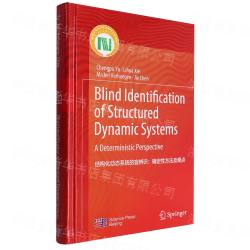-
内容大纲
This book is intended for researchers active in the field of (blind) system identification and aims to provide new identification ideas/insights for dealing with challenging system identification problems. It presents a comprehensive overview of the state-of-the-art in the area, which would save a lot of time and avoid collecting the scattered information from research papers, reports and unpublished work. Besides, it is a self-contained book by including essential algebraic, system and optimization theories, which can help graduate students enter the amazing blind system identification world with less effort. -
作者介绍
-
目录
1 Introduction
1.1 Examples of the Blind System Identification
1.2 Optimization Based Blind System Identification
1.3 Blind Identification of Various System Models
1.4 Organization of This Book
References
Part I Preliminaries
2 Linear Algebra and Polynomial Matrices
2.1 Vector Space and Basis
2.2 Eigenvalue Decomposition
2.3 Singular Value Decomposition
2.4 Orthogonal Projection and Oblique Projection
2.5 Sum and Intersection of Subspaces
2.6 Angles Between Subspaces
2.7 Polynomial Matrices and Polynomial Bases
2.8 Summary
References
3 Representation of Linear System Models
3.1 Transfer Functions
3.1.1 Properties of Coprime Matrix Fraction
3.1.2 Verification and Computation of Coprime Matrix Fraction
3.2 State Space Models
3.3 State Space Realization
3.4 HankelMatrix Interpretation
3.5 Structured State-Space Models
3.5.1 Graph Theory
3.5.2 Structured Algebraic System Theory
3.6 Summary
Reference
4 Identification of LTI Systems
4.1 Least-Squares Identification
4.1.1 Identifiability of a Rational Transfer Function Matrix
4.1.2 Least-Squares Identification Method
4.2 Subspace Identification
4.2.1 Subspace Identification via Orthogonal Projection
4.2.2 Subspace Identification via State Estimation
4.2.3 Subspace Identification via State Compensation
4.2.4 Subspace Identification via Markov Parameter Estimation
4.3 Parameterized State-Space Identification
4.3.1 Gradient-BasedMethod
4.3.2 Difference-of-Convex Programming Method
4.4 Summary
References
Part II Blind System Identification with a Single Unknown Input
5 Blind Identification of SIMO FIR Systems
5.1 Structured Subspace Factorization
5.1.1 Blind Identification of FIR Filters
5.1.2 Blind Identification of a Source Signal
5.2 Cross RelationMethod
5.3 Least-Squares Smoothing Method
5.3.1 Blind FIR Filter Identification
5.3.2 Blind Source Signal Estimation
5.4 Blind Identification of Time-Varying FIR Systems
5.4.1 Input Signal Estimation
5.4.2 Time-Varying Filter Identification
5.5 Blind Identification of Nonlinear SIMO Systems
5.5.1 SIMO-Wiener System Identification
5.5.2 Hammerstein-Wiener System Identification
5.6 Summary
References
6 Blind Identification of SISO IIR Systems via Oversampling
6.1 Oversampling of FIR and IIR Systems
6.1.1 Multirate Identities
6.1.2 Multirate Transfer Functions
6.1.3 Multirate State-Space Models
6.2 Coprime Conditions for Lifted SIMO Systems
6.3 Blind Identification of Non-minimum Phase Systems
6.4 Blind Identification of Hammerstein Systems
6.4.1 Blind Identifiability
6.4.2 Blind Identification Approach
6.5 Blind Identification of Output Switching Systems
6.6 Summary
References
7 Distributed Blind Identification of Networked FIR Systems
7.1 Motivation for the Distributed Blind Identification
7.2 Distributed Blind System Identification Using Noise-Free Data
7.2.1 Distributed Blind Identification Algorithm
7.2.2 Convergence Analysis
7.2.3 Numerical Simulation
7.3 Distributed Blind System Identification Using Noisy Data
7.3.1 Distributed Blind Identification Algorithm
7.3.2 Convergence Analysis
7.3.3 Numerical Simulation
7.4 Recursive Blind Source Equalization Using Noisy Data
7.4.1 Direct Distributed Equalization
7.4.2 Indirect Distributed Equalization
7.4.3 Distributed Blind Equalization with Noise-Free Measurements
7.4.4 Distributed Blind Equalization with Noisy Measurements
7.4.5 Blind Equalization with a Time-Varying Topology
7.4.6 Numerical Simulation
7.5 Summary
References
Part III Blind System Identification with Multiple Unknown Inputs
8 Blind Identification of MIMO Systems
8.1 Blind Identification ofMIMO FIR Systems
8.1.1 Identifiability Analysis
8.1.2 Subspace Blind Identification Method
8.2 Blind Identification of Multivariable State-Space Models
8.2.3 Blind Identification of Numerator Polynomial Matrices
8.2.4 Numerical Simulation
8.3 Summary
References
9 Blind Identification of Structured State-Space Models
9.1 Strong Observability of Structured State-Space Models
9.1.1 Maximum Unobservable Subspace
9.1.2 State Estimation with Unknown Inputs
9.2 Blind Identification of Multivariable State-Space Models
9.2.1 Identifiability Analysis
9.2.2 Subspace-Based Blind Identification Method
9.2.3 Numerical Simulations
9.3 Blind System Identification Excited by Different Unknown Inputs
9.3.1 Identifiability Analysis
9.3.2 Subspace Identification Method
9.4 Summary
References
10 Blind Local Identification of Large-Scale Networked Systems
10.1 Local Network Identification
10.2 Subspace Identification Approach
10.3 Subspace Identification of Unknown Inputs
10.3.1 Estimation of Completely Unmeasurable Inputs
10.4 Numerical Simulations
10.5 Summary
References
11 Conclusions
11.1 About the Identification Object
11.2 About the Identifiability Analysis
11.3 About the Identification Method
11.4 Artificial Intelligence Driven Blind System Identification
References
Index
同类热销排行榜
- 故宫日历(公历2017年)(精)26.4
- 时间简史(插图版)18
- 工程数学线性代数(第6版十二五普通高等教育本科国家级规划教材)7.76
- 昆虫记(精)/经典译林8.72
- 数控铣床综合实训教程19.2
- 昆虫记(插图典藏本)(精)11.2
- 化工制图习题集(普通高等教育规划教材)7.2
- 化工制图(普通高等教育规划教材)15.8
- 生命急救技能14
- 时间简史(普及版)(精)15.2
推荐书目
-

孩子你慢慢来/人生三书 华人世界率性犀利的一枝笔,龙应台独家授权《孩子你慢慢来》20周年经典新版。她的《...
-

时间简史(插图版) 相对论、黑洞、弯曲空间……这些词给我们的感觉是艰深、晦涩、难以理解而且与我们的...
-

本质(精) 改革开放40年,恰如一部四部曲的年代大戏。技术突变、产品迭代、产业升级、资本对接...

 [
[
